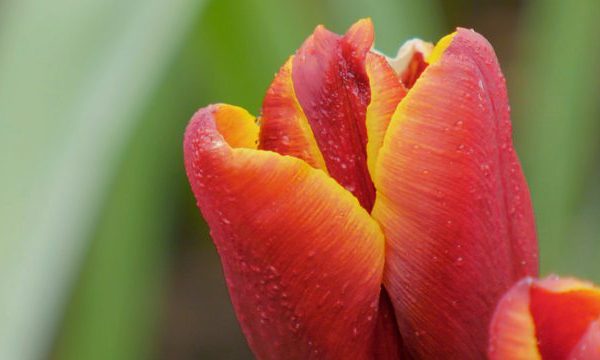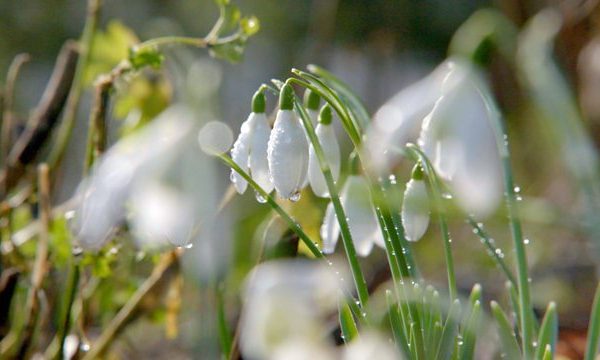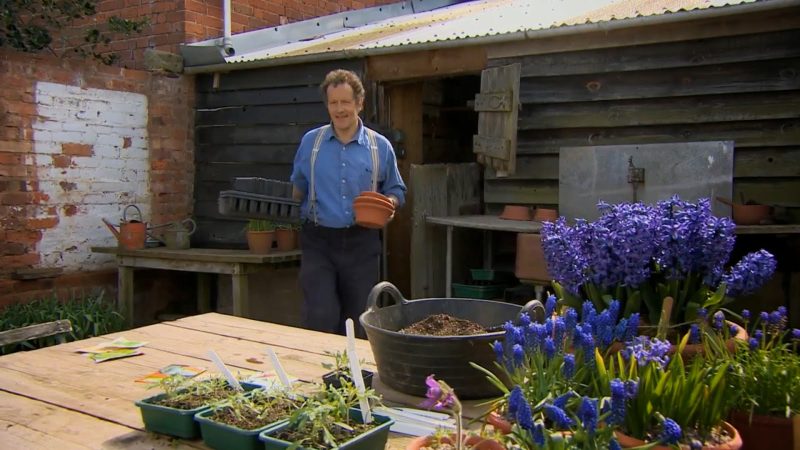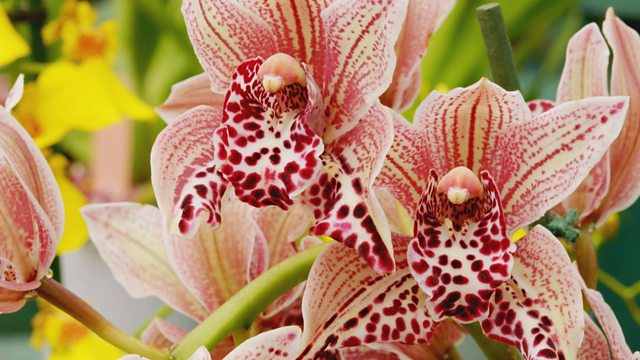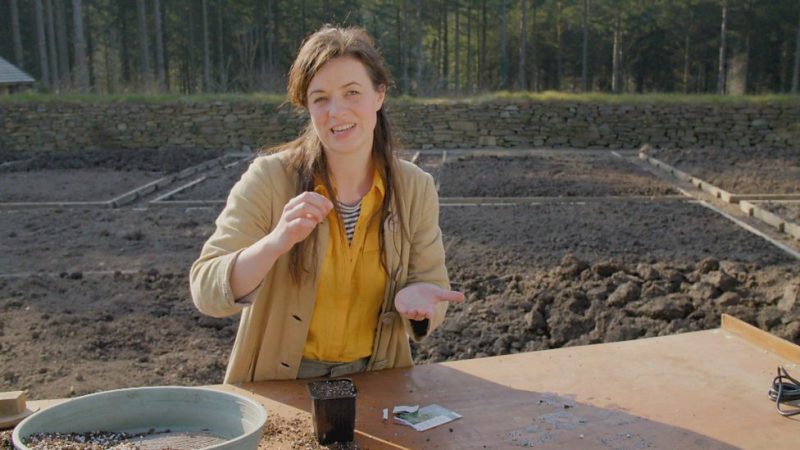Gardeners World episode 2 2016: Monty is busily preparing his garden for a new season, pruning roses and growing lilies in pots. Learn more about this season’s changes on our blog! As we gently ease into a new season of gardening at the scenic Longmeadow, our dedicated horticulturist, Monty, is busily immersing himself in the labor of love that defines his picturesque garden. Engaging in a meticulous process of spring cleaning, he is devotedly tidying up the ornamental grass border that has become a signature display of this flourishing garden. In his ceaseless pursuit of perfection, Monty is also devoted to the careful pruning of his roses. These blooms, loved for their vibrant colors and fragrant perfumes, are nurtured with exceptional care, ensuring they continue to enchant visitors and gardening enthusiasts alike.
On another front, Monty has embarked on the promising endeavor of growing lilies, specifically in pots. These beautiful, striking flowers, known for their distinct aroma and delicate petals, are a testament to Monty’s gardening prowess, as he meticulously oversees their progress from sprouts to full blooms.
Adding to the gardening expertise on display, Joe Swift, an authority on arboreal matters, diligently continues his informative series on trees. In his next session, he will be sharing invaluable tips on tree planting. Joe, with his wealth of experience, explains the ins and outs of this crucial process, providing essential advice on how to plant a tree for the utmost success in the future. His guide aims to enable every aspiring gardener to foster a deep-rooted connection with nature, ensuring their trees thrive and contribute to a lush, verdant landscape.
Rachel de Thame follows a fragrant trail and explains how even the tiniest of flowers pack a punch in the perfume stakes. And, in the first of several visits, we join the head gardener of Britain’s most famous garden at Sissinghurst as he sets out his plans to restore it to its original vision.
Gardeners World episode 2 2016
Growing lilies in pots
Lilies can be grown in the ground, but on heavy, clay soils have a tendency to rot. Underground slugs can be a major problem too. One solution is to grow them in cheap plastic pots which you can then sink into the border at a later date. The alternative is to plant them in something more decorative on the patio. Whichever sort of pot you choose, it needs to be deep.
There are two main types of lily: Oriental and Asiatic. Garden centre packs are often labelled as such and it’s important to know the difference. Oriental lilies generally come in white or various shades of pink, and are nearly always highly scented. As a rule, they won’t tolerate alkaline conditions and so are best grown in an ericaceous compost for acid-loving plants. Asiatic lilies, on the other hand, tend to be brightly coloured with no scent. They are very hardy and will tolerate the lime present in most multi-purpose composts.
Unlike other bulbs, lilies lack a protective outer coat and so are very prone to drying out. Look for plump bulbs and plant straight away! If they look rather shrivelled, consider buying them from a specialist mail-order supplier. All lilies demand good drainage, so it’s worth using lots of crocks in the bottom of your pot. For best results, plant your lilies deep with 15cm (6in) of compost on top. Three bulbs to a 35cm (14in) pot is fine.
If lily beetle is a major problem in your garden, consider growing Lilium regale, the Regal lily. It’s an easy one to grow and research has shown that it is less susceptible to attack.
Another thing to bear in mind is that all parts of a lily are poisonous to cats, not just the pollen.
The Comprehensive Guide to Growing Lilies in Your Garden
Growing lilies in your garden can be a rewarding and beautiful experience. These elegant flowers not only enhance the aesthetic appeal of your outdoor space but are also relatively easy to cultivate with the right knowledge. This article will guide you through the essential steps and tips for successfully growing lilies, leveraging expert insights and proven techniques.
Understanding the Basics of Lily Cultivation
Choosing the Right Variety and Planting Location
Before planting, it’s crucial to select the right variety of lilies for your garden. Lilies come in numerous types, such as Asiatic, Oriental, and Trumpet lilies, each with unique characteristics and growing requirements. Lily Lovers – The Ultimate Guide to Growing Lilies provides an excellent resource for understanding the different varieties available.
Once you’ve chosen your lilies, selecting an ideal location is next. Most lilies thrive in full sun, requiring 6 to 8 hours of direct sunlight daily. However, in hotter climates, they appreciate some afternoon shade. The Old Farmer’s Almanac highlights the importance of sun exposure for lilies’ growth.
Preparing the Soil
Lilies flourish in fertile, well-drained soil. Preparing your garden bed by enriching the soil with organic matter and ensuring good drainage is crucial. The RHS Gardening guide on growing lilies provides detailed information on soil preparation for optimal lily growth.
Planting and Caring for Your Lilies
Planting Lily Bulbs
When planting lily bulbs, depth and spacing are critical. As a rule of thumb, plant bulbs at a depth of about three times their height and space them approximately 12 to 15 inches apart. This spacing allows for sufficient air circulation and reduces the risk of disease. For detailed instructions on planting, refer to DutchGrown’s Growing Guide.
Watering and Fertilizing
Regular watering is essential, especially during the growing season. Lilies prefer consistently moist soil but be cautious of overwatering to avoid rot. Fertilizing lilies every few weeks during their growing season can promote healthier blooms and stronger growth. BBC Gardeners World Magazine offers excellent tips on watering and fertilizing lilies.
Deadheading and Seasonal Care
Deadheading, the process of removing spent flowers, encourages more blooms and prevents seed production, which can sap energy from the plant. As the seasons change, so do the care requirements for your lilies. American Meadows provides insights into seasonal care for lilies.
Troubleshooting Common Lily Issues
Pest and Disease Management
Lilies can be susceptible to certain pests and diseases. Regularly inspecting your plants and addressing issues promptly can help maintain their health. Effective pest and disease management strategies are crucial for thriving lilies. For more on this topic, Garden Design’s article on lily care is a valuable resource.
Adapting to Climate Variations
Lilies generally adapt well to a range of climates, but extreme weather conditions can pose challenges. Understanding how to protect your lilies from harsh weather conditions is key to their survival and bloom. The article 8 Tips for Growing Better Lilies offers great advice on adapting to different climate conditions.
Embracing Home Composting: A Step Towards an Eco-Friendly Lifestyle
The Power of Home Composting
Home composting is more than just a hobby; it’s an eco-friendly lifestyle choice. It’s the simplest, most natural way to recycle kitchen and garden waste. When you engage in home composting, you’re doing more than just reducing waste – you’re creating a valuable soil improver, a veritable gold mine for your garden. Like magic, composting transforms scraps and clippings into a nutrient-rich elixir that fosters plant growth. Think of it as your garden’s secret weapon, a testament to the marvels of nature’s recycling system.
Unearthing the Benefits of Composting
Beneath the humble compost heap, a complex process unfolds. This process is a symbiotic dance between organic waste and microorganisms, creating a cascade of benefits for your home and the environment.
One of the most tangible benefits is the production of nutrient-rich compost. This black gold improves soil structure, retains moisture, and supplies essential nutrients to your plants. It’s a gardener’s dream and a significant advantage for those seeking self-sufficiency in their gardening endeavors.
Composting at home also reduces the amount of waste going into landfill sites. When organic material decomposes in a landfill, it generates methane, a potent greenhouse gas. By composting, you’re not only cutting down on waste but also reducing your carbon footprint.
Composting: A Journey of Sustainability
Composting at home fosters a sense of responsibility towards the environment. It’s a practical, hands-on way to contribute to sustainability, allowing us to return nutrients back to the earth and close the loop in our consumption cycle.
There’s something rewarding about witnessing the transformation of everyday waste into a valuable resource. It’s a process that nurtures a deeper connection with the natural world, reminding us of our role as stewards of the environment. Composting is more than just an environmentally friendly way of dealing with waste; it’s a testament to the cycles of life and decay, a tangible reminder of the intricate balances that sustain us.
The Basics of Home Composting
Starting your own composting operation at home might seem daunting, but it’s actually quite simple. All you need are green and brown organic materials. Green materials are things like vegetable scraps, coffee grounds, or fresh grass clippings – they’re rich in nitrogen. Brown materials, on the other hand, are items like dry leaves, straw, or shredded newspaper – they’re high in carbon.
The secret to successful composting lies in the balance of these two types of materials. A ratio of about 3:1, browns to greens, is a good starting point. Remember, composting is more art than science, and it’s perfectly fine to adjust as you go along.
Beyond the Basics: Tips and Tricks
But successful composting goes beyond just mixing greens and browns. One crucial aspect is size. Smaller pieces decompose faster, so chop, shred, or break up your materials to speed up the process. Another important factor is aeration. Compost needs oxygen to decompose properly. To ensure good aeration, turn your compost pile with a pitchfork or compost turner every couple of weeks. Lastly, don’t forget about moisture. Your compost pile should be as damp as a wrung-out sponge. If it’s too dry, it won’t decompose effectively. If it’s too wet, it can become smelly.
Composting: A Gateway to a Greener Future
There’s no denying that composting takes effort. It requires time, energy, and a willingness to get your hands dirty. But the rewards – for your garden, your wallet, and the planet – are immense. By adopting composting, we’re acknowledging our role in the natural world and taking steps to minimize our impact. We’re working with nature, rather than against it, to transform waste into wealth. And in doing so, we’re not just creating healthier, more fertile soil – we’re planting the seeds for a more sustainable, more environmentally-friendly future.
Planting Roses: A Comprehensive Guide to Cultivating Beauty
The Enchantment of Roses: A Historical Perspective
Roses, with their ethereal beauty and intoxicating scent, have captivated humanity for centuries. The ancient Egyptians, for instance, cherished roses as symbols of life and love, incorporating them into their daily lives and sacred rituals. Their fascination sparked a flame that burns brightly to this day, fueling our collective desire to fill our gardens with these splendid blooms.
To understand the allure of roses, we must first delve into their rich history. Steeped in legend and lore, roses have transcended geographical boundaries and cultural divides to find a place in the heart of every civilization. They’ve been used to convey powerful emotions, from the deepest love to the sharpest sorrow, and everything in between.
Yet, for all their symbolism, roses are, at their core, a celebration of nature’s ingenuity. They serve as a testament to the sheer diversity and resilience of life on Earth, with thousands of varieties flourishing in every imaginable habitat, from arid deserts to lush rainforests.
The Art of Planting Roses: Understanding the Basics
Planting roses is an art form, one that requires patience, diligence, and an understanding of the fundamentals. To ensure that your roses bloom to their full potential, you must consider several key factors, including soil quality, sunlight, and watering practices.
First and foremost, roses thrive in well-drained soil enriched with organic matter. This nourishing foundation provides the necessary nutrients for healthy growth. When preparing the soil, be sure to remove any weeds or stones that could hinder the root development of your roses.
Sunlight is another crucial element in rose cultivation. These sun-loving plants require at least six hours of direct sunlight each day. The more sunlight they receive, the more profuse their blooming. Position your roses in a spot that gets ample morning sun to avoid the harsh afternoon rays.
As for watering, consistency is key. Roses prefer a steady supply of water, but overwatering can lead to root rot, a common issue among rose growers. Striking a balance between too much and too little water can be challenging, but it’s essential for the well-being of your roses.
Choosing the Right Rose Variety for Your Garden
Choosing the right rose for your garden is a deeply personal decision, influenced by factors such as climate, soil type, and personal preference. Some gardeners might be drawn to the classic elegance of hybrid teas, while others might prefer the charm of old-fashioned roses.
When selecting a variety, consider the rose’s growth habit. Some roses, like climbers, are perfect for trellises and pergolas, while shrub roses are ideal for borders and hedges. The size and shape of the rose plant can dramatically impact the aesthetic of your garden, so choose wisely.
How to Plant Your Chosen Rose
Once you’ve selected your rose, it’s time to get your hands dirty. The process of planting roses might seem daunting, but with a bit of knowledge and some practical tips, you’ll soon be well on your way to cultivating your own rose garden.
First, dig a hole that’s wide and deep enough to accommodate the root ball of your rose. This is typically about 15-20 inches in diameter and deep enough that the bud union – the swollen part of the stem where the rose variety was grafted onto the rootstock – is level with or slightly above the ground. This ensures your rose has enough space to establish a robust root system.
Place your rose in the hole, spreading the roots out gently. Backfill the hole with a mix of garden soil and compost, firming it gently around the base of the plant. Water thoroughly and mulch the surrounding area to conserve moisture and suppress weeds.
Remember, your newly planted rose will need consistent care during its first year, including regular watering and protection from harsh weather conditions.
Nurturing Your Roses to Full Bloom
The art of rose gardening doesn’t end with planting. Indeed, nurturing your roses to full bloom is a journey that requires ongoing care and attention.
Fertilizing your roses regularly is crucial to promote healthy growth and abundant blooming. Use a balanced rose fertilizer that provides essential nutrients, including nitrogen, phosphorous, and potassium. Additionally, supplementing with organic matter such as compost can boost soil health and improve the vitality of your roses.
Pruning is another essential aspect of rose care. It promotes vigorous growth, improves air circulation, and shapes the plant. Prune your roses in late winter or early spring when they’re dormant, removing dead or diseased wood and thinning out crowded growth.
Finally, monitor your roses for signs of pests or disease. Aphids, blackspot, and rust are common issues in rose gardens, but with prompt action, they can be managed effectively.
The Joy of Growing Roses: An Unending Love Affair
Planting roses is more than just a gardening task—it’s an expression of love for nature and a testament to the beauty of life. As your roses bloom, they’ll fill your garden with their vibrant colors and enchanting scents, providing you with endless moments of joy and satisfaction.
Remember, each rose has its own unique character and charm, and part of the fun is discovering these nuances as you care for your garden. It’s an unending love affair, one that deepens with each passing season and each new bloom. Embrace the journey of growing roses. In the process, you’ll not only create a stunning garden, but you’ll also cultivate a deeper connection with the natural world. Happy planting!
F.A.Q. on Gardeners World Episode 2 2016: Growing Lilies and Roses
Q.: What are the key activities featured in the Gardeners World episode 2 2016?
A.: This episode showcases Monty Don’s garden preparations for a new season, focusing on pruning roses and growing lilies in pots. It also includes insights from Joe Swift on tree planting and Rachel de Thame’s exploration of the fragrance of small flowers.
Q.: What are Monty Don’s main tasks in his garden during this episode?
A.: Monty Don is seen busily engaging in spring cleaning, tidying up the ornamental grass border, and pruning roses. He is also shown undertaking the task of growing lilies in pots, demonstrating meticulous care in nurturing these flowers from sprouts to full blooms.
Q.: What specific gardening tips does Joe Swift provide in this episode?
A.: Joe Swift, an authority on trees, continues his informative series by sharing valuable tips on tree planting. He offers essential advice on the process, aiming to help every aspiring gardener succeed in planting and nurturing trees.
Q.: How are lilies grown in pots, and what are the important considerations?
A.: Lilies can be grown in pots to avoid issues like soil rot and underground pests. Key considerations include choosing the right type of lily (Oriental or Asiatic), ensuring good drainage, and planting the bulbs deep with adequate compost. It’s also important to select plump bulbs and manage pests, such as the lily beetle.
Q.: What are some essential tips for rose cultivation featured in this episode?
A.: For successful rose cultivation, it’s important to ensure good soil preparation, provide adequate sunlight, and maintain proper watering. The episode emphasizes the need for careful pruning and selection of the right rose variety for one’s garden, considering factors like growth habit and soil type.
